Smallest Bird
Male bee hummingbirds (mellisuga helenae), which live in Cuba, weigh 0.056 ounces and are 2.75 inches in length. The bill and tail account for half of this length.
Smallest Bird of Prey
The black-legged falconet ( Micrphierax fringlius ) of southeast Asia and the white-fronted or Bornean falconet ( M. latifrons ) of northwestern Borneo both have an average length of 5.5-6 inches, including a 2 inch tail, and weigh approximately 1.25 ounces.
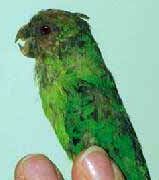 Smallest Parrot
Smallest Parrot
[contributed by Harold Armitage, Wild Macaws Wild Macaws]
The Pygmy parrots of Papua and nearby islands. Genus Micropsitta. There's six different sorts - Yellow-capped, Buff-faced, Finsch's, Geelvink, Meek's, Red-breasted - all around 3" long (8cm). Thought to eat lichens and mosses but not much is known about their lifestyles.
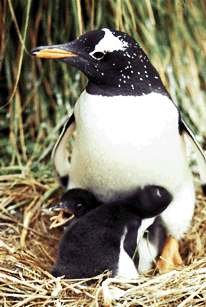 Fastest Swimming Bird
Fastest Swimming Bird
Gentoo Penguin found on the Antarctic Islands can swim 40 km per hour. Large populations are found at South Georgia, Falkland Islands, and Iles Kerguelen although their breeding distribution is circumpolar. An orange bill and a white stroke behind its eye distinguish the black and white gentoos from the smaller adelie and chinstrap species. Long stiff tail feathers stick out behind as they walk, often cocked up in the water, no other penguin has such a prominent tail. They breed in winter at the more northerly sub-Antarctic islands, laying two eggs as early as July. Can dive over 300' though most prey dives are shallower. Most dives last only half a minute.
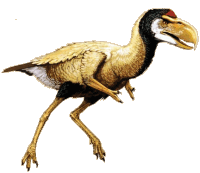 Largest Carnivorous Bird
Largest Carnivorous Bird
(contribution by Christoph Kulmann)
Titanis Walleri. This bird is known from the early Pleistocene (Ice Age) of Florida. It is the last known member of the family Phorusrhacidae, a group of large, flightless birds which evolved in South America. This creature had an estimated body height of 3 meters (if it stood fully erect, and 2.5 meters in more normal situations). Titanis really had arms instead of wings.
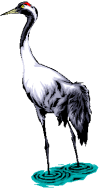 Tallest Flying Birdscrane
Tallest Flying Birdscrane
The largest cranes (family Gruidae) can be almost 6 ft. 6 in. tall.
Heaviest Flying Birds
The Kori Bustard or paauw (Ardeotis Kori) of northeast and southern Africa and the great bustard (Otis tarda) of Europe and Asia weigh about 40-42 pounds. There is a report of a 46 lb. 4 oz. male great bustard shot in northeastern China. It was too heavy to fly.
Heaviest Birds of Prey
Andean condors (Vultur gryphus) are the heaviest species of bird of prey. Males weigh 20-27 pounds and have a wingspan of at least 10 feet. A male California condor (Gymnogyps californianus) preserved in the California Academy of Sciences is reported to weigh 31 pounds. It is rare for the species to exceed 23 pounds in weight.
Heaviest Parrot
Flightless Kakapo around 7lbs in weight; New Zealand [contributed by Harold Armitage, Wild Macaws Wild Macaws]
SinbadA flightless nocturnal bird, which was described by early European settlers as " the most wonderful bird on Earth, " the Kakapo parrot was once endemic throughout New Zealand. Today only 50 birds remain, some of which live on Little Barrier Island (Hauturu) as part of a Department of Conservation endangered species recovery programme.
The name "Kakapo" is Polynesian (Maori) for "parrot of the night." Moss green, like Kakapo "Suzanne's" foster brood, Codfish Island, 2002. Photo by Don Merton/DOC.the foliage of the native trees and grasses in which it evolved, funny and cuddly, with a wonderful spicy fragrance, this unique bird has small wings, useless for flight but handy to steer with when you're jumping down a bank, and a rudimentary keel in its sternum. It browses forest trees, ferns, herbs, moss and lichen and grinds its food between a powerful lower mandible and a grooved pad in the upper mandible, a method of mastication which is thought to be unique.
Longest Feathers
The phoenix fowl or Yokohama chicken (a strain of the red junglefowl Gallus is bred in Japan for ornamental purposes. A rooster with a 34 ft. 9.5 in. Tail covert was reported in 1972.
Longest Bills
The bill of the Australian pelican (Pelicanus conspicillatus) is 13-18.5 inches long.
The longest beak in relation to body length is that of the sword- billed hummingbird ( Ensifera ) of the Andes. At 4 inches, the beak is longer than the bird’s body (excluding the tail).
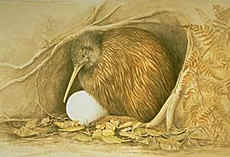 Only Nostrils on tip of Beak
Only Nostrils on tip of Beak
The Kiwi is the only bird with nostrils at the tip of its beak. Whereas other birds hunt by sight or by hearing, the national bird of New Zealand uses its beaky nostrils to sniff out food at night. Although the Kiwi is roughly the same size as a chicken, it lays an egg which is 10 times larger than a hen's. It also has wings but cannot fly.
Biggest Eyes
The ostrich has the largest eyes of any land animal. Each eye can be up to 2 inches in diameter.
Largest Field of Vision
The eyes of the woodcock are set so far back in its head that it has a 360 degree field of vision, enabling it see all round and even over the top of its head
Best Talker
The African Grey Parrot has been called "the perfect mix of brains and beauty" (Bird Talk, Aug. 92) and the "cadillac of parrots" (Bird Talk Sept. 93). Much of the notoriety of this species stems from the phenomenal gift of speech members exhibit. While many parrots learn some words or phrases, many cases have been documented of African Greys learning multiple lines of songs, prayers, or plays. The Guinness Book of World Records lists the best talking parrot or parrot like bird as a African Grey named Prudle. Prudle was captured near Jinja, Uganda in 1958 and when "he" retired from public life in 1977 had a vocabulary of nearly 1000 words. Many owners have been surprised (and sometimes shocked) when their Grey learned a new word or phrase after hearing it only a few times. One of our favorite stories in this respect was one related by a priest that had a pet Grey. While hanging some pictures in his office, the priest hit his hand with a hammer. He let out a stream of obscenities that his Grey learned (from this one occurrence according to the priest). The priest's embarrassment was compounded by the other aspect of greys gift for mimicking, that is they often sound exactly like the person that spoke the words or phrase. [contributed by Harold Armitage, Wild Macaws Wild Macaws]
Most Airborne Bird
The sooty tern (Sterna fuscata) leaves its nesting grounds as a youngster and remains aloft for 3-10 years, settling on water from time to time. It returns to land to breed as an adult.
Longest Flight
A common tern (Sterna hirundo) that was banded in June 1996 in Finland was recaptured alive 16,250 miles away at Rotamah Island, Victoria, Australia in January 1997. It had traveled at a rate of 125 miles a day.
Slowest-Flying Birds
The American woodcock (Scolopax minor) and the Eurasian woodcock (S. Rusticola) have both been timed lying at 5 mph with out stalling during courtship displays.
Slowest Wing beat
The slowest wing beats recorded during true level flight averaged one per second. They were by several species of the New World vulture ( family Cathartidea)
Largest Wingspan
The wandering albatross (Diomedea exulans) has the largest wingspan of any living bird. As a result, it is an expert glider and it is capable of remaining in the air without beating its wings for several hours at a time. The largest known specimen was an extremely old male with and 11 ft. 11 in. wingspan. It was caught in the Tasman Sea in September 1965. It has also been known to sleep while it flies!
Largest Ever Wingspan
The South American teratoron ( Argentavis magnificens), which existed 6-8 million years ago, had an estimated wingspan of 25 feet.
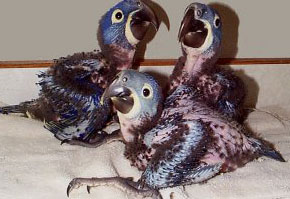 Parrot with largest Wingspan
Parrot with largest Wingspan
Hyacinth Macaw, around 1100 mm - Brazil [contributed by Harold Armitage, Wild Macaws Wild Macaws] The Hyacinth macaw is the most majestic of all parrots. Although the Hyacinth Macaw and Green Wing Macaw are both commonly referred to as the "gentle giant" of the macaw species. The Hyacinths are truly the "dream bird" of all bird lovers. The Hyacinth macaw can attain the total length of up to 42 inches and have a beak pressure that can easily disassemble a welded wrought iron cage bar by bar in a very short time. In spite of their tremendous strength, this is one of the most laid back and easy-going of all of the macaws.
Fastest Flying Bird
The peregrine falcon (Falco peregrinus) is the fastest living creature, reaching speeds of at least 124 mph and possibly as much as 168 mph when swooping from great heights during territorial displays or while catching pry birds in midair.
Fastest Wing beat
The horned sungem (Heliactin cornuta), a hummingbird from South America, beats its wings up and down 90 times a second.
Flying Backwards
While hummingbirds are probably the champions of backwards flight they are by no means the only birds that can fly in this way. When two herons or egrets fight, periodically one of them caught at a disadvantage in the dispute will flutter backward. Occasionally warblers fluttering at the tip of a branch as they pick off insects will flutter backward when they overshoot some flying insect. It is probable that any bird which uses fluttering flight can move backward when pressed to do so.
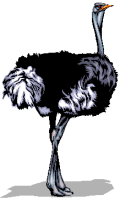 Fastest Land Bird
Fastest Land Bird
Despite its bulk, the ostrich can run at speeds of up to 45 mph if necessary.
Highest-Flying Birds
A Ruppell’s vulture (gyps rueppellii) collided with a commercial aircraft over Abidjan, Ivory Coast, at an altitude of 37,000 feet in November 1973. The impact damaged one of the aircraft’s engines, but the plane landed safely. The species is rarely seen above 20,000 feet.
In 1967, about 30 whooper swans (Cygnus were spotted at an altitude of just over 27,000 feet by an airline pilot over the Western Isles, UK. They were flying from Iceland to Loch Foyle on the Northern Ireland/republic Ireland border. Their altitude was confirmed by air traffic control.
Longest Stride
The stride of an ostrich may exceed 23 feet in length when the bird is sprinting.
Highest G-Force Borne
The beak of the red-headed woodpecker (Melanerpes erythrocephalus) hits the bark of a tree with an impact of velocity of 13 mph, subjection the bird’s brain to a deceleration of approximately 10 g when its head snaps back. Other woodpeckers may experience and even higher g-force.
Most Food Consumed
Hummingbirds (family Trochilidon) requires at least half their own body weight in food (mainly nectar and tiny insects) every single day. With the possible exception of shrews, they have the highest metabolic rate of any known animal.
Strangest Diet
An ostrich living at the London Zoo, England was found to have swallowed an alarm clock, a roll of film, a handkerchief, a 3-foot long piece of rope, a cycle valve , a pencil, three gloves, a collar stud, a Belgian franc, four halfpennies and two farthings.
Longest Fast
The male emperor penguin (Aptenodytes forsteri) spends several months without feeding on the frozen wastes of the Antarctic sea ice. It travels overland from the sea to the breeding colony, courts the female, incubates the egg for 62-67 days, waits for the female to return and travels back to the open sea, going without food for up to 134 days.
Largest Prey
The peregrine falcon (Falco peregrinus) is believed to be able to spot a pigeon from a distance of more than 5 miles under ideal conditions.
Biggest Nest
The incubation mounds built by the mallee fowl (Leipoa ocellata) of Australia are up to 15 feet tall and 35 feet wide. A nest site is estimated to weigh 330 tons.
A 9 ft. 6 in. Wide 20 foot deep nest was built by a pair of bald eagles ( Haliaeetus leucocephalus), and possibly by their successors, close to St Petersburg, Florida. When examined in 1963, the nest was estimated to weigh in excess of 2.2 tons.
Smallest Nests
The vervian hummingbird ( Mellisuga minima) builds a nest about half the size of a walnut shell. The deeper but narrower nest of the bee hummingbird (M. Helenae) is thimble sized.
Smallest Egg
The smallest known bird’s egg were tow vervain hummingbird (Mellisuga minima) eggs less than 39/100 inch long. They weighed 0.365 g. (0.0128 oz.) And 0.375 g (0.0132 oz.)
Biggest Eggs
(contribution by Christoph Kulmann)
The extinct giant elephant bird (Aephornis maximus) - picture below under heaviest birds - laid 1 foot long eggs with a lElephant Bird egg compared to chicken eggliquid capacity of 2.25 gallons- the equivalent of seven ostrich eggs and more than 12,000 humming bird eggs. When early Arabian and Indian explorers started returning from their journeys along the coast of Africa with stories of gigantic birds many times the size of a man, they brought evidence...huge eggs, up to three feet in circumference. They were the eggs of a bird that would later come to be known as the Elephant Bird, or Vouron Patra (Aepyornis maximus). The eggs that the Elephant Bird laid were larger than the largest dinosaur eggs, and, in fact, they were as large as a structurally functional egg could possibly be...the largest single cells to have ever existed on Earth.
The ostrich egg is 6-8 inches long. 4-6 inches in diameter and weighs 2 lb. 3 oz. - 3 lb.14 oz.. It is equal in volume to 24 chicken eggs. The shell is 3/50 inch thick but can support eh weight of an adult human. The largest on record was laid in 1988 by a two year old northern/southern hybrid (Struthio c. camelus x s. c. australis) at the Kibbutz Ha’on collective farm, Israel. Ti weighted 5 lb. 2 oz.
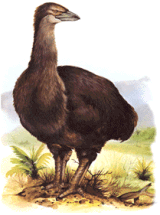 Heaviest Bird Ever Alive - 2 candidates
Heaviest Bird Ever Alive - 2 candidates
(contribution by Christoph Kulmann)
Elephant BirdThe Elephant Bird (shown above under biggest eggs) is thought to have been the inspiration for the Roc (or Ruhk) made famous in the stories of Sinbad and the accounts of Marco Polo. While Aepyornis was by no means as large and terrible as the elephant-eating Roc, it WAS one of the largest birds that ever lived. The flightless bird grew to around ten or eleven feet tall, and is estimated to have weighed up to 1100 pounds. By comparison, a BIG Ostrich will go eight feet and 300 pounds. The home of the Elephant Bird was the island of Madagascar, off the eastern coast of Africa. The island was first populated by African and Indonesian peoples that are thought to have arrived around the time of Christ, about 2000 years ago. They were, in turn, visited by Muslim traders from East Africa and the Comoro Islands in the ninth century. The first Europeans to visit the island were the Portuguese in 1500, but Europeans didn't really establish a foothold on the island until the French settled there beginning in 1642. The Elephant Bird was probably still around at that time but it had already become very rare. One of the only contemporary European accounts of the bird was written by the first French Governor of Madagascar, Étienne de Flacourt, who wrote, in 1658, "vouropatra - a large bird which haunts the Ampatres and lays eggs like the ostriches; so that the people of these places may not take it, it seeks the most lonely places." The natives' histories of the Elephant Bird, however, rarely describe it as an aggressive bird, and more often portray it as a shy, peaceful giant. Most likely the Vouron Patra was driven to extinction by people raiding their nests. The eggs and egg shells were both very important items to the tribal Malagasy, who used them for food and all kinds of stuff. The fossil record shows that maximus was not the only species of Aepyornis that ever lived. It is thought that between three and seven different types of Elephant Bird have lived since the Pleistocene although only one, the smaller Aepyornis mullerornis is thought to have survived into historic times along with the Elephant Bird. Only the giant is known to have co-existed with humans, and by 1700, it too was gone.
Only the largest of the New Zealand Moas were taller, some reaching thirteen feet, but they weren't as massively built. Moa were large flightless birds that went extinct in the late 1700's or early 1800's. These huge, bulky birds lived in lowland forests on the islands of New Zealand. The word moa comes from the Maori language, in which the plural of moa is moa (we are using that convention). The oldest-known moa fossils date from 2.4 million years ago. The last of the moa (the smaller species) lived on the South Island of New Zealand until the 1700's. On its native New Zealand, there were no large mammals to prey on the moa or its eggs; its only predators large birds, like the Haast eagle (which is now extinct). When the Maori people moved to New Zealand over 1,000 years ago, they destroyed much of the moa's lowland forest habitat and introduced mammals, including dogs and rats. These mammals ate the moa's eggs. The Maori people also hunted and ate the moa. These forces probably contributed to the extinction of the moa. The moa had a large body, a small head, a long neck, short, thick legs, and a large beak. There were 11 species of moa. The largest was almost 11.5 feet (3.5 m) tall and weighed perhaps 700 pounds (320 kg); the smallest of the moa were turkey-sized. The moa's nest was located on the ground (leaving the eggs vulnerable to predators). The moa was an herbivore (plant-eater); it ate fruit and some plant material (like leaves). These birds swallowed stones (which went into gizzard) that helped digest the food. Classification: Kingdom Animalia (animals), phylum Chordata, subphylum Vertebrata (vertebrates), class Aves (birds), order Dinornithiformes, family Anomalopterygidae (the lesser moa) and family Dinornithidae (the greater moa). There were 11 (or possibly 13) different species of moa, including Dinornis, the biggest moa and the biggest bird that ever lived.
In ancient Australia, until 50,000 years ago, there was a group of birds called the Dromornithids. By far the largest of them was "Dromornis stirtoni", a massive creature that stood 3 meters tall and must have weighed more than half a ton. They disappeared rather abruptly, and there is still much debate about the reasons. But the Australians seem to have kept a memory of these giant birds. In some legends, there is a creature called "mihirung", and most likely this means a dromornithid bird.
Smelliest Bird
The south American hoatzin (Opisthocomus hoazin) has an odor similar to cow manure. Colombians call it pava hedionda ("stinking pheasant"). The cause of the smell is believed to be a combination of its diet of green leaves and its specialized digestive system, which involves a kind of foregut fermentation.
Large Flocks
Flamingoes, with their long necks and legs, have a height range of 3-5 feet and are the biggest bird to form large flocks. Of the four species, the lesser flamingo (Phoeniconaias minor) of eastern and southern Africa has been seen in flocks of several million birds, particularly in the Great Lakes of eastern Africa.
Biggest Bird
The largest and strongest living bird is the North African ostrich (Struthio camelus . Males can be up to 9 feet tall and weigh 345 pounds, and when fully grown the have one of the most advanced immune systems of any animal. South Africa was the first country to see the commercial potential of ostrich products - the creature are prized not only for their large soft white feathers and their meat but also for their skins, which are made into the strongest commercially available leather in the world. Ostrich farming is believed to have begun in the Karoo and Eastern Cape c. 1863. By 1910 there were more than 20,000 domesticated ostriches in the country, and by 1913 ostrich feathers were the fourth most important south African export product. Demand began to dry up soon afterwards, but there was an ostrich revival in the 1920's when farmers started to produce biltong ( dry strips of ostrich meat) commercially.
Biggest Seabird
(contribution by Jacob Casson)
The Northern Royal Albatross (Diomedea epomophora sanfordi) with a wing span 3 metres, flight speed up to 115 km/h. 80% of life spent at sea. White body, black on backs of wings. Feeds on surface shoaling fish and squid. Male and female equal share in rearing chick, raising one chick every two years. Mature at six years, live about 45 years. Mate in October, one egg laid in November, incubation 79 days. Chick guarded for first six weeks, young depart late September.
Biggest Cockatoo
Sub-species Proboscigar Aterimus Goliath. The weight of the female Palm Cockatoo is between 500-950 grams, and the males weigh between 540-1100 grams. Both females and males height range from 49-68 centimeters. The wings are about 35.1 centimeters, the tail about 23.8 centimeters, the bill about 9.1 centimeters, and the tarsus about 3.5 centimeters. These Palm Cockatoos are very large birds. They are the largest of all parrots. The scientific name is derived from both Greek and Latin. Proboscis is Greek for nose, gero is Greek for carry, and atterimus is Latin for black. Most Palm Cockatoos are dark gray and black with a cheek-patch of bare red skin . The cheek skin color may change according to their level of stress, it may change pink or beige if it is stressed, or if it is excited it will turn yellow. Palm Cockatoos have a very strong mandible, which they use for cracking nuts.
Most Abundant Bird
The red- billed quelea (Quelea quelea) of Africa has an estimated adult breeding population of 1.5 billion. The slaughter of at least 200 million of them each year has no impact on this number.
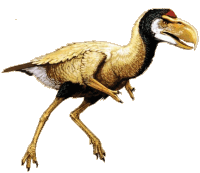 Rarest Bird
Rarest Bird
With 168 birds on the list of the world's most critically endangered creatures--and many of them from remote, inhospitable places--researchers cannot say for sure which species is the rarest. But that dubious distinction may belong to the po'ouli (pronounced "poh-oh-U-lee"). This Hawaiian honeycreeper, whose name means "black-faced," survives only in a few hundred acres of nearly impenetrable rain forest on the windward side of Maui's Haleakala Crater. At last count, the known po'ouli population was six. And with time running out, experts are scrambling to find a way to save the species from extinction.
Rarest Parrot
Spix's Macaw. Endemic to one small area of northeastern Brazil, in a habitat known as the "caatinga" (an arid region of flat savanna scrubland interspersed with seasonal creeks and gallery forests), the Spix's Macaw was considered to be extinct in the wild 10 years ago. Despite concerted efforts of the Brazilian government and an international committee whose members include the aviculturists that hold this endangered species, government officials, conservationists and ornithologists the last one died in 2001. The conservation of this species is now dependent on the success of the captive-breeding and field program. The global captive population has grown significantly from a low of 11 known birds to 60 (54 of which are captive-hatched); new holders are participating in the program, the field research program has collected valuable data on the natural history of this species and the ecology of the region, a strong community outreach program is in place, habitat protection and restoration projects are ongoing, and basic research on psittacine reintroduction techniques has been successfully completed. [contributed by Harold Armitage, Wild Macaws Wild Macaws]
Bossiest Bird
The kea ( Nestor notabilis) from New Zealand is the only bird known to have a society in which the higher status individuals force others to work for them.
Most Unusual Birds
As a bird flap its wings it disturbs the air and leaves whirling eddies behind. Some gregarious species take advantage of the upward sections of these whirls and each bird in the V-formation stations itself at the correct place so the inner wing obtains support from the wake of the bird immediately ahead. Thus every bird in the flock except the leader saves energy by using the V-formation type of flight.
Male bee hummingbirds (mellisuga helenae), which live in Cuba, weigh 0.056 ounces and are 2.75 inches in length. The bill and tail account for half of this length.
Smallest Bird of Prey
The black-legged falconet ( Micrphierax fringlius ) of southeast Asia and the white-fronted or Bornean falconet ( M. latifrons ) of northwestern Borneo both have an average length of 5.5-6 inches, including a 2 inch tail, and weigh approximately 1.25 ounces.
 Smallest Parrot
Smallest Parrot[contributed by Harold Armitage, Wild Macaws Wild Macaws]
The Pygmy parrots of Papua and nearby islands. Genus Micropsitta. There's six different sorts - Yellow-capped, Buff-faced, Finsch's, Geelvink, Meek's, Red-breasted - all around 3" long (8cm). Thought to eat lichens and mosses but not much is known about their lifestyles.
 Fastest Swimming Bird
Fastest Swimming BirdGentoo Penguin found on the Antarctic Islands can swim 40 km per hour. Large populations are found at South Georgia, Falkland Islands, and Iles Kerguelen although their breeding distribution is circumpolar. An orange bill and a white stroke behind its eye distinguish the black and white gentoos from the smaller adelie and chinstrap species. Long stiff tail feathers stick out behind as they walk, often cocked up in the water, no other penguin has such a prominent tail. They breed in winter at the more northerly sub-Antarctic islands, laying two eggs as early as July. Can dive over 300' though most prey dives are shallower. Most dives last only half a minute.
 Largest Carnivorous Bird
Largest Carnivorous Bird(contribution by Christoph Kulmann)
Titanis Walleri. This bird is known from the early Pleistocene (Ice Age) of Florida. It is the last known member of the family Phorusrhacidae, a group of large, flightless birds which evolved in South America. This creature had an estimated body height of 3 meters (if it stood fully erect, and 2.5 meters in more normal situations). Titanis really had arms instead of wings.
 Tallest Flying Birdscrane
Tallest Flying BirdscraneThe largest cranes (family Gruidae) can be almost 6 ft. 6 in. tall.
Heaviest Flying Birds
The Kori Bustard or paauw (Ardeotis Kori) of northeast and southern Africa and the great bustard (Otis tarda) of Europe and Asia weigh about 40-42 pounds. There is a report of a 46 lb. 4 oz. male great bustard shot in northeastern China. It was too heavy to fly.
Heaviest Birds of Prey
Andean condors (Vultur gryphus) are the heaviest species of bird of prey. Males weigh 20-27 pounds and have a wingspan of at least 10 feet. A male California condor (Gymnogyps californianus) preserved in the California Academy of Sciences is reported to weigh 31 pounds. It is rare for the species to exceed 23 pounds in weight.
Heaviest Parrot
Flightless Kakapo around 7lbs in weight; New Zealand [contributed by Harold Armitage, Wild Macaws Wild Macaws]
SinbadA flightless nocturnal bird, which was described by early European settlers as " the most wonderful bird on Earth, " the Kakapo parrot was once endemic throughout New Zealand. Today only 50 birds remain, some of which live on Little Barrier Island (Hauturu) as part of a Department of Conservation endangered species recovery programme.
The name "Kakapo" is Polynesian (Maori) for "parrot of the night." Moss green, like Kakapo "Suzanne's" foster brood, Codfish Island, 2002. Photo by Don Merton/DOC.the foliage of the native trees and grasses in which it evolved, funny and cuddly, with a wonderful spicy fragrance, this unique bird has small wings, useless for flight but handy to steer with when you're jumping down a bank, and a rudimentary keel in its sternum. It browses forest trees, ferns, herbs, moss and lichen and grinds its food between a powerful lower mandible and a grooved pad in the upper mandible, a method of mastication which is thought to be unique.
Longest Feathers
The phoenix fowl or Yokohama chicken (a strain of the red junglefowl Gallus is bred in Japan for ornamental purposes. A rooster with a 34 ft. 9.5 in. Tail covert was reported in 1972.
Longest Bills
The bill of the Australian pelican (Pelicanus conspicillatus) is 13-18.5 inches long.
The longest beak in relation to body length is that of the sword- billed hummingbird ( Ensifera ) of the Andes. At 4 inches, the beak is longer than the bird’s body (excluding the tail).
 Only Nostrils on tip of Beak
Only Nostrils on tip of BeakThe Kiwi is the only bird with nostrils at the tip of its beak. Whereas other birds hunt by sight or by hearing, the national bird of New Zealand uses its beaky nostrils to sniff out food at night. Although the Kiwi is roughly the same size as a chicken, it lays an egg which is 10 times larger than a hen's. It also has wings but cannot fly.
Biggest Eyes
The ostrich has the largest eyes of any land animal. Each eye can be up to 2 inches in diameter.
Largest Field of Vision
The eyes of the woodcock are set so far back in its head that it has a 360 degree field of vision, enabling it see all round and even over the top of its head
Best Talker
The African Grey Parrot has been called "the perfect mix of brains and beauty" (Bird Talk, Aug. 92) and the "cadillac of parrots" (Bird Talk Sept. 93). Much of the notoriety of this species stems from the phenomenal gift of speech members exhibit. While many parrots learn some words or phrases, many cases have been documented of African Greys learning multiple lines of songs, prayers, or plays. The Guinness Book of World Records lists the best talking parrot or parrot like bird as a African Grey named Prudle. Prudle was captured near Jinja, Uganda in 1958 and when "he" retired from public life in 1977 had a vocabulary of nearly 1000 words. Many owners have been surprised (and sometimes shocked) when their Grey learned a new word or phrase after hearing it only a few times. One of our favorite stories in this respect was one related by a priest that had a pet Grey. While hanging some pictures in his office, the priest hit his hand with a hammer. He let out a stream of obscenities that his Grey learned (from this one occurrence according to the priest). The priest's embarrassment was compounded by the other aspect of greys gift for mimicking, that is they often sound exactly like the person that spoke the words or phrase. [contributed by Harold Armitage, Wild Macaws Wild Macaws]
Most Airborne Bird
The sooty tern (Sterna fuscata) leaves its nesting grounds as a youngster and remains aloft for 3-10 years, settling on water from time to time. It returns to land to breed as an adult.
Longest Flight
A common tern (Sterna hirundo) that was banded in June 1996 in Finland was recaptured alive 16,250 miles away at Rotamah Island, Victoria, Australia in January 1997. It had traveled at a rate of 125 miles a day.
Slowest-Flying Birds
The American woodcock (Scolopax minor) and the Eurasian woodcock (S. Rusticola) have both been timed lying at 5 mph with out stalling during courtship displays.
Slowest Wing beat
The slowest wing beats recorded during true level flight averaged one per second. They were by several species of the New World vulture ( family Cathartidea)
Largest Wingspan
The wandering albatross (Diomedea exulans) has the largest wingspan of any living bird. As a result, it is an expert glider and it is capable of remaining in the air without beating its wings for several hours at a time. The largest known specimen was an extremely old male with and 11 ft. 11 in. wingspan. It was caught in the Tasman Sea in September 1965. It has also been known to sleep while it flies!
Largest Ever Wingspan
The South American teratoron ( Argentavis magnificens), which existed 6-8 million years ago, had an estimated wingspan of 25 feet.
 Parrot with largest Wingspan
Parrot with largest WingspanHyacinth Macaw, around 1100 mm - Brazil [contributed by Harold Armitage, Wild Macaws Wild Macaws] The Hyacinth macaw is the most majestic of all parrots. Although the Hyacinth Macaw and Green Wing Macaw are both commonly referred to as the "gentle giant" of the macaw species. The Hyacinths are truly the "dream bird" of all bird lovers. The Hyacinth macaw can attain the total length of up to 42 inches and have a beak pressure that can easily disassemble a welded wrought iron cage bar by bar in a very short time. In spite of their tremendous strength, this is one of the most laid back and easy-going of all of the macaws.
Fastest Flying Bird
The peregrine falcon (Falco peregrinus) is the fastest living creature, reaching speeds of at least 124 mph and possibly as much as 168 mph when swooping from great heights during territorial displays or while catching pry birds in midair.
Fastest Wing beat
The horned sungem (Heliactin cornuta), a hummingbird from South America, beats its wings up and down 90 times a second.
Flying Backwards
While hummingbirds are probably the champions of backwards flight they are by no means the only birds that can fly in this way. When two herons or egrets fight, periodically one of them caught at a disadvantage in the dispute will flutter backward. Occasionally warblers fluttering at the tip of a branch as they pick off insects will flutter backward when they overshoot some flying insect. It is probable that any bird which uses fluttering flight can move backward when pressed to do so.
 Fastest Land Bird
Fastest Land BirdDespite its bulk, the ostrich can run at speeds of up to 45 mph if necessary.
Highest-Flying Birds
A Ruppell’s vulture (gyps rueppellii) collided with a commercial aircraft over Abidjan, Ivory Coast, at an altitude of 37,000 feet in November 1973. The impact damaged one of the aircraft’s engines, but the plane landed safely. The species is rarely seen above 20,000 feet.
In 1967, about 30 whooper swans (Cygnus were spotted at an altitude of just over 27,000 feet by an airline pilot over the Western Isles, UK. They were flying from Iceland to Loch Foyle on the Northern Ireland/republic Ireland border. Their altitude was confirmed by air traffic control.
Longest Stride
The stride of an ostrich may exceed 23 feet in length when the bird is sprinting.
Highest G-Force Borne
The beak of the red-headed woodpecker (Melanerpes erythrocephalus) hits the bark of a tree with an impact of velocity of 13 mph, subjection the bird’s brain to a deceleration of approximately 10 g when its head snaps back. Other woodpeckers may experience and even higher g-force.
Most Food Consumed
Hummingbirds (family Trochilidon) requires at least half their own body weight in food (mainly nectar and tiny insects) every single day. With the possible exception of shrews, they have the highest metabolic rate of any known animal.
Strangest Diet
An ostrich living at the London Zoo, England was found to have swallowed an alarm clock, a roll of film, a handkerchief, a 3-foot long piece of rope, a cycle valve , a pencil, three gloves, a collar stud, a Belgian franc, four halfpennies and two farthings.
Longest Fast
The male emperor penguin (Aptenodytes forsteri) spends several months without feeding on the frozen wastes of the Antarctic sea ice. It travels overland from the sea to the breeding colony, courts the female, incubates the egg for 62-67 days, waits for the female to return and travels back to the open sea, going without food for up to 134 days.
Largest Prey
- The wild animal known to have been killed and carried away by a bird was a 15 pound male red howler monkey killed by a harpy eagle (Harpia harpyja) in Manu National Park, Peru in 1990. The harpy eagle is considered the world’s most powerful bird of prey, although it weighs only 20 pounds.
- An incredible video of a Golden Eagle taking a small Mountain sheep or goat and carrying it off to it's nest. www.youtube.com/watch?v=4irYqe5yjcE
- The largest documented prey taken by a Philippine eagle is a 14 kg (30.8 lbs) Philippine deer Cervus at a nest studied by Kennedy in 1985. also on records; a mature female monkey taken and carrying it in one foot in Cagayan; and a large python.
- The African crowned eagle is Africa's most powerful and ferocious eagle in terms of the weight and nature of prey taken. Mammalian prey, especially duikers, may weigh up to 34 kg (75 lbs) and still be preyed on by these eagles.
The peregrine falcon (Falco peregrinus) is believed to be able to spot a pigeon from a distance of more than 5 miles under ideal conditions.
Biggest Nest
The incubation mounds built by the mallee fowl (Leipoa ocellata) of Australia are up to 15 feet tall and 35 feet wide. A nest site is estimated to weigh 330 tons.
A 9 ft. 6 in. Wide 20 foot deep nest was built by a pair of bald eagles ( Haliaeetus leucocephalus), and possibly by their successors, close to St Petersburg, Florida. When examined in 1963, the nest was estimated to weigh in excess of 2.2 tons.
Smallest Nests
The vervian hummingbird ( Mellisuga minima) builds a nest about half the size of a walnut shell. The deeper but narrower nest of the bee hummingbird (M. Helenae) is thimble sized.
Smallest Egg
The smallest known bird’s egg were tow vervain hummingbird (Mellisuga minima) eggs less than 39/100 inch long. They weighed 0.365 g. (0.0128 oz.) And 0.375 g (0.0132 oz.)
Biggest Eggs
(contribution by Christoph Kulmann)
The extinct giant elephant bird (Aephornis maximus) - picture below under heaviest birds - laid 1 foot long eggs with a lElephant Bird egg compared to chicken eggliquid capacity of 2.25 gallons- the equivalent of seven ostrich eggs and more than 12,000 humming bird eggs. When early Arabian and Indian explorers started returning from their journeys along the coast of Africa with stories of gigantic birds many times the size of a man, they brought evidence...huge eggs, up to three feet in circumference. They were the eggs of a bird that would later come to be known as the Elephant Bird, or Vouron Patra (Aepyornis maximus). The eggs that the Elephant Bird laid were larger than the largest dinosaur eggs, and, in fact, they were as large as a structurally functional egg could possibly be...the largest single cells to have ever existed on Earth.
The ostrich egg is 6-8 inches long. 4-6 inches in diameter and weighs 2 lb. 3 oz. - 3 lb.14 oz.. It is equal in volume to 24 chicken eggs. The shell is 3/50 inch thick but can support eh weight of an adult human. The largest on record was laid in 1988 by a two year old northern/southern hybrid (Struthio c. camelus x s. c. australis) at the Kibbutz Ha’on collective farm, Israel. Ti weighted 5 lb. 2 oz.
 Heaviest Bird Ever Alive - 2 candidates
Heaviest Bird Ever Alive - 2 candidates(contribution by Christoph Kulmann)
Elephant BirdThe Elephant Bird (shown above under biggest eggs) is thought to have been the inspiration for the Roc (or Ruhk) made famous in the stories of Sinbad and the accounts of Marco Polo. While Aepyornis was by no means as large and terrible as the elephant-eating Roc, it WAS one of the largest birds that ever lived. The flightless bird grew to around ten or eleven feet tall, and is estimated to have weighed up to 1100 pounds. By comparison, a BIG Ostrich will go eight feet and 300 pounds. The home of the Elephant Bird was the island of Madagascar, off the eastern coast of Africa. The island was first populated by African and Indonesian peoples that are thought to have arrived around the time of Christ, about 2000 years ago. They were, in turn, visited by Muslim traders from East Africa and the Comoro Islands in the ninth century. The first Europeans to visit the island were the Portuguese in 1500, but Europeans didn't really establish a foothold on the island until the French settled there beginning in 1642. The Elephant Bird was probably still around at that time but it had already become very rare. One of the only contemporary European accounts of the bird was written by the first French Governor of Madagascar, Étienne de Flacourt, who wrote, in 1658, "vouropatra - a large bird which haunts the Ampatres and lays eggs like the ostriches; so that the people of these places may not take it, it seeks the most lonely places." The natives' histories of the Elephant Bird, however, rarely describe it as an aggressive bird, and more often portray it as a shy, peaceful giant. Most likely the Vouron Patra was driven to extinction by people raiding their nests. The eggs and egg shells were both very important items to the tribal Malagasy, who used them for food and all kinds of stuff. The fossil record shows that maximus was not the only species of Aepyornis that ever lived. It is thought that between three and seven different types of Elephant Bird have lived since the Pleistocene although only one, the smaller Aepyornis mullerornis is thought to have survived into historic times along with the Elephant Bird. Only the giant is known to have co-existed with humans, and by 1700, it too was gone.
Only the largest of the New Zealand Moas were taller, some reaching thirteen feet, but they weren't as massively built. Moa were large flightless birds that went extinct in the late 1700's or early 1800's. These huge, bulky birds lived in lowland forests on the islands of New Zealand. The word moa comes from the Maori language, in which the plural of moa is moa (we are using that convention). The oldest-known moa fossils date from 2.4 million years ago. The last of the moa (the smaller species) lived on the South Island of New Zealand until the 1700's. On its native New Zealand, there were no large mammals to prey on the moa or its eggs; its only predators large birds, like the Haast eagle (which is now extinct). When the Maori people moved to New Zealand over 1,000 years ago, they destroyed much of the moa's lowland forest habitat and introduced mammals, including dogs and rats. These mammals ate the moa's eggs. The Maori people also hunted and ate the moa. These forces probably contributed to the extinction of the moa. The moa had a large body, a small head, a long neck, short, thick legs, and a large beak. There were 11 species of moa. The largest was almost 11.5 feet (3.5 m) tall and weighed perhaps 700 pounds (320 kg); the smallest of the moa were turkey-sized. The moa's nest was located on the ground (leaving the eggs vulnerable to predators). The moa was an herbivore (plant-eater); it ate fruit and some plant material (like leaves). These birds swallowed stones (which went into gizzard) that helped digest the food. Classification: Kingdom Animalia (animals), phylum Chordata, subphylum Vertebrata (vertebrates), class Aves (birds), order Dinornithiformes, family Anomalopterygidae (the lesser moa) and family Dinornithidae (the greater moa). There were 11 (or possibly 13) different species of moa, including Dinornis, the biggest moa and the biggest bird that ever lived.
In ancient Australia, until 50,000 years ago, there was a group of birds called the Dromornithids. By far the largest of them was "Dromornis stirtoni", a massive creature that stood 3 meters tall and must have weighed more than half a ton. They disappeared rather abruptly, and there is still much debate about the reasons. But the Australians seem to have kept a memory of these giant birds. In some legends, there is a creature called "mihirung", and most likely this means a dromornithid bird.
Smelliest Bird
The south American hoatzin (Opisthocomus hoazin) has an odor similar to cow manure. Colombians call it pava hedionda ("stinking pheasant"). The cause of the smell is believed to be a combination of its diet of green leaves and its specialized digestive system, which involves a kind of foregut fermentation.
Large Flocks
Flamingoes, with their long necks and legs, have a height range of 3-5 feet and are the biggest bird to form large flocks. Of the four species, the lesser flamingo (Phoeniconaias minor) of eastern and southern Africa has been seen in flocks of several million birds, particularly in the Great Lakes of eastern Africa.
Biggest Bird
The largest and strongest living bird is the North African ostrich (Struthio camelus . Males can be up to 9 feet tall and weigh 345 pounds, and when fully grown the have one of the most advanced immune systems of any animal. South Africa was the first country to see the commercial potential of ostrich products - the creature are prized not only for their large soft white feathers and their meat but also for their skins, which are made into the strongest commercially available leather in the world. Ostrich farming is believed to have begun in the Karoo and Eastern Cape c. 1863. By 1910 there were more than 20,000 domesticated ostriches in the country, and by 1913 ostrich feathers were the fourth most important south African export product. Demand began to dry up soon afterwards, but there was an ostrich revival in the 1920's when farmers started to produce biltong ( dry strips of ostrich meat) commercially.
Biggest Seabird
(contribution by Jacob Casson)
The Northern Royal Albatross (Diomedea epomophora sanfordi) with a wing span 3 metres, flight speed up to 115 km/h. 80% of life spent at sea. White body, black on backs of wings. Feeds on surface shoaling fish and squid. Male and female equal share in rearing chick, raising one chick every two years. Mature at six years, live about 45 years. Mate in October, one egg laid in November, incubation 79 days. Chick guarded for first six weeks, young depart late September.
Biggest Cockatoo
Sub-species Proboscigar Aterimus Goliath. The weight of the female Palm Cockatoo is between 500-950 grams, and the males weigh between 540-1100 grams. Both females and males height range from 49-68 centimeters. The wings are about 35.1 centimeters, the tail about 23.8 centimeters, the bill about 9.1 centimeters, and the tarsus about 3.5 centimeters. These Palm Cockatoos are very large birds. They are the largest of all parrots. The scientific name is derived from both Greek and Latin. Proboscis is Greek for nose, gero is Greek for carry, and atterimus is Latin for black. Most Palm Cockatoos are dark gray and black with a cheek-patch of bare red skin . The cheek skin color may change according to their level of stress, it may change pink or beige if it is stressed, or if it is excited it will turn yellow. Palm Cockatoos have a very strong mandible, which they use for cracking nuts.
Most Abundant Bird
The red- billed quelea (Quelea quelea) of Africa has an estimated adult breeding population of 1.5 billion. The slaughter of at least 200 million of them each year has no impact on this number.
 Rarest Bird
Rarest BirdWith 168 birds on the list of the world's most critically endangered creatures--and many of them from remote, inhospitable places--researchers cannot say for sure which species is the rarest. But that dubious distinction may belong to the po'ouli (pronounced "poh-oh-U-lee"). This Hawaiian honeycreeper, whose name means "black-faced," survives only in a few hundred acres of nearly impenetrable rain forest on the windward side of Maui's Haleakala Crater. At last count, the known po'ouli population was six. And with time running out, experts are scrambling to find a way to save the species from extinction.
Rarest Parrot
Spix's Macaw. Endemic to one small area of northeastern Brazil, in a habitat known as the "caatinga" (an arid region of flat savanna scrubland interspersed with seasonal creeks and gallery forests), the Spix's Macaw was considered to be extinct in the wild 10 years ago. Despite concerted efforts of the Brazilian government and an international committee whose members include the aviculturists that hold this endangered species, government officials, conservationists and ornithologists the last one died in 2001. The conservation of this species is now dependent on the success of the captive-breeding and field program. The global captive population has grown significantly from a low of 11 known birds to 60 (54 of which are captive-hatched); new holders are participating in the program, the field research program has collected valuable data on the natural history of this species and the ecology of the region, a strong community outreach program is in place, habitat protection and restoration projects are ongoing, and basic research on psittacine reintroduction techniques has been successfully completed. [contributed by Harold Armitage, Wild Macaws Wild Macaws]
Bossiest Bird
The kea ( Nestor notabilis) from New Zealand is the only bird known to have a society in which the higher status individuals force others to work for them.
Most Unusual Birds
- The home of the Great Indian Hornbill is a prison. When the female is ready to lay her eggs, she hides in a hole in a tree. The male then seals up the hole, leaving her just a narrow slit through which he passes her food. The female stays in there until the chicks are a few months old, when she breaks out and helps the male with feeding duties.
- The Secretary Bird may have long legs but it can't run. Instead it hops along the African scrublandin search of its staple diet of snakes and lizards. The bird gets its name from the 20 black crest feathers behind its ears which are reminiscent of the old quill pens once favored by secretaries.
- The Quetzal from central America has such a long tail (up to 3 feet) that it can't take off from a branch in the normal way without ripping its tail to shreds. So instead it launches itself backwards into space like a parachutist leaving an aircraft. The Quetzal nests in hollow trees but has to reverse into the hole. Once inside, it curls up its tail over its head and out of the hole.
- The Male Bower-Bird from Australia attracts a female by building an elaborate love bower. After building a little hut out of twigs, he decorates it with flowers and colorful objects such as feathers, fruit, shells, and pebbles or sometimes glass and paper if the nest is near civilization. One particular species (the Atlas Bower-Bird) actually paints the walls by dipping bark or leaves into the blue or dark-green saliva he secretes. The entire bower-building procedure can take months and the bird will often change the decorations until he is happy with them. When finally satisfied, he performs a love dance outside the bower, sometimes offering the female a pretty item from his collection.
- The Young Hoatzin of the Amazon forests has claws on its wings to help it clamber through the dense undergrowth. The bird is a throwback to the prehistoric archeopteryx, which also had three claws on each wing.
- The Little Tailorbird uses its sharp beak to pierce holes along the edges of two leaves. It then constructs a nest by neatly stitching the leaves together with pieces of grass.
As a bird flap its wings it disturbs the air and leaves whirling eddies behind. Some gregarious species take advantage of the upward sections of these whirls and each bird in the V-formation stations itself at the correct place so the inner wing obtains support from the wake of the bird immediately ahead. Thus every bird in the flock except the leader saves energy by using the V-formation type of flight.

No comments:
Post a Comment